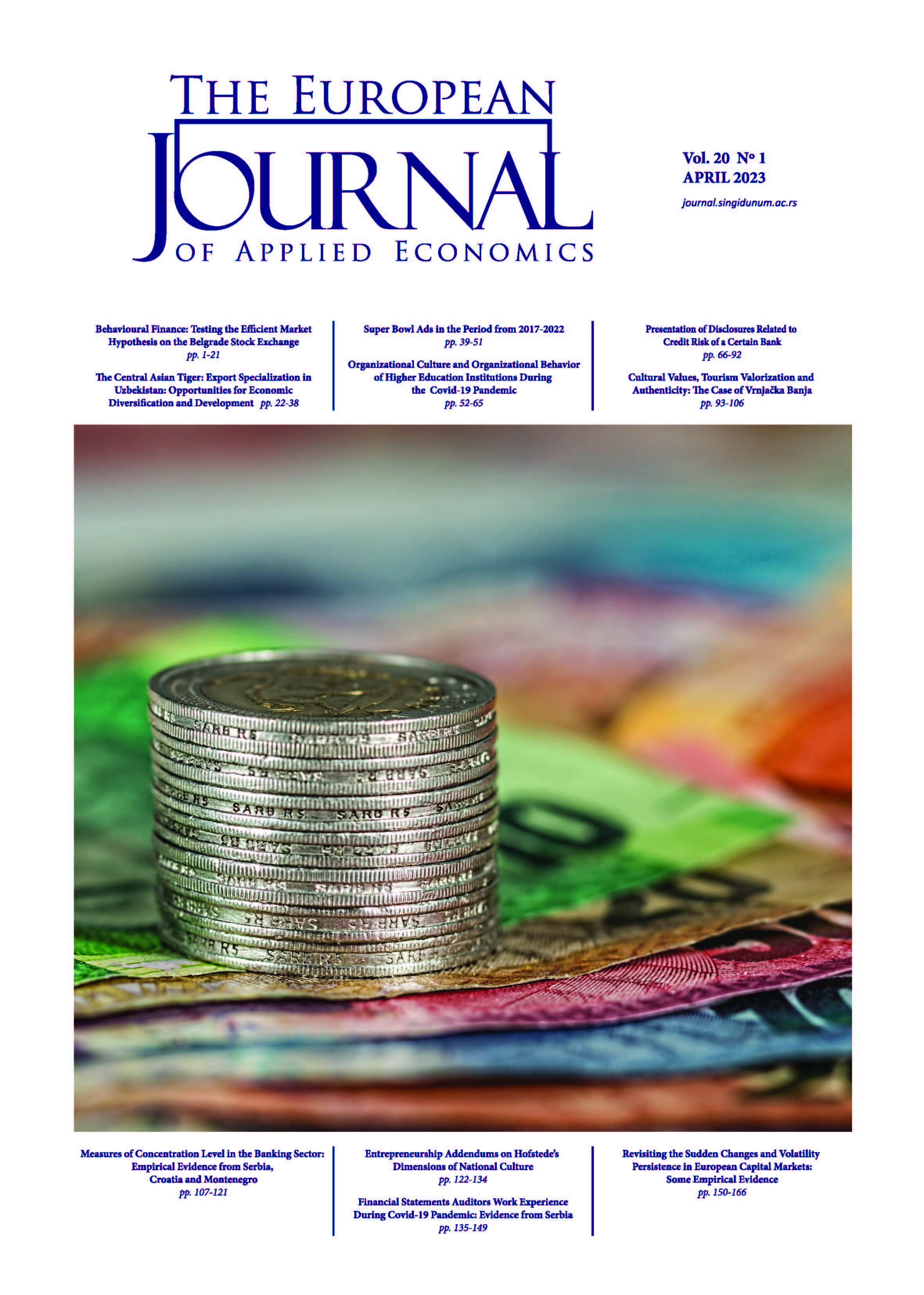PRESENTATION OF DISCLOSURES RELATED TO CREDIT RISK OF A CERTAIN BANK
Abstract
The appearance of credit risk is one of the key dangers for the banking portfolio, because if it becomes impossible to collect claims from several key clients, the bank could remain insolvent. Recent financial crises have highlighted the need for banks to identify, measure, assess and control credit risk, as well as to ensure an adequate level of capital to cover potential losses in the event of loan defaults. Therefore, risk management relies heavily on the direct application of mathematical and statistical methods and models, as well as on the use of their results for business purposes. The aim of this paper is to gain knowledge about the effect of credit risk on financial performance of bank in a changing world, bearing in mind that credit risk management is one of the indicators of the results of banking operations of a certain bank.
References
Apanga, M. A., Appiah, K. O., & Arthur, J. (2016). Credit risk management of Ghanaian listed banks. International Journal of Law and Management, 58(2), 162–178.
Barjaktarović, L. (2015). Upravljanje rizikom. Beograd: Univerzitet Singidunum
Baud, C. & Chiapello, E. (2017). Understanding the disciplinary aspects of neoliberal regulations: The case of credit-risk regulation under the Basel Accords. Critical Perspectives on Accounting, 46, 3-23, DOI: 10.1016/j.cpa.2016.09.005.
Bessis, J. (2015). Risk Management in banking. Hoboken, New Jersey: Wiley
Cucinelli, D., Di Battista, M., Marchese, M. & Nieri, L. (2018). Credit risk in European banks: The bright side of the internal ratings-based approach. Journal of Banking & Finance, 93, 213-229, DOI: 10.1016/j.jbankfin.2018.06.014.
Drennan, L. T. & McConnell., A. (2007). Risk and Crisis Management in the Public Sector. Abingdon, England: Routledge
Đukić, Đ. (2021). Upravljanje rizicima i kapitalom u bankama. Beograd: Ekonomski fakultet
Ekinci, R. & Poyraz, G. (2019). The Effect of Credit Risk on Financial Performance of Deposit Banks In Turkey. Procedia Computer Science, 158, 979-987, DOI: 10.1016/j.procs.2019.09.139
ERSTE BANK, Financial Statements, Retrieved November 22, 2022, from https://www.erstebank.rs/en/about-us/financial-statements
Ferhi, A. (2018). Credit risk and banking stability: a comparative study between Islamic and conventional banks, International Journal of Law and Management, 60(4), 1009-1019. DOI: 10.1108/IJLMA-05-2017-0112
Feridun, M. & Özün, A. (2020). Basel IV implementation: a review of the case of the European Union. Journal of Capital Markets Studies, 4(1), 7-24, DOI: 10.1108/JCMS-04-2020-0006
Gulati, R., Goswami, A. & Kumar, S. (2019). What drives credit risk in the Indian banking industry? An empirical investigation. Economic Systems, 43(1), 42-62, DOI: 10.1016/j.ecosys.2018.08.004
Hilscher, J. & Wilson, M. (2016). Credit Ratings and Credit Risk: Is One Measure Enough? Management Science, 63(10), DOI: https://doi.org/10.1287/mnsc.2016.2514
Hull, C.J. (2018). Risk Management and Financial Institutions. Hoboken, New Jersey: John Wiley and Sons
IFRS Foundation (2022). IFRS Accounting Standards - Retrieved November 15, 2022, from https://www.ifrs.org/issued-standards/list-of-standards/
Jones, E. & Zeitz, A. (2017). The Limits of Globalizing Basel Banking Standards. Journal of Financial Regulation, 3(1), 89–124, DOI: 10.1093/jfr/fjx001
Kanapickienė, R., Keliuotytė-Staniulėnienė, G., Teresienė. D., Špicas, R., & Neifaltas, A. (2022). Macroeconomic Determinants of Credit Risk: Evidence on the Impact on Consumer Credit in Central and Eastern European Countries. Sustainability, 14(20):13219. DOI: 10.3390/su142013219
Koju, L., Koju, R. & Wang, S. (2018). Does Banking Management Affect Credit Risk? Evidence from the Indian Banking System. International Journal of Financial Studies. 6(3): 67. DOI: 10.3390/ijfs6030067
Law on banks (2015). Official Gazette of RS, no. 107/2005, 91/2010 and 14/2015 - Retrieved November 12, 2022, from https://www.paragraf.rs/propisi/zakon_o_bankama.html
Lin, S. (2009). A new two-stage hybrid approach of credit risk in banking industry. Expert Systems with Applications, 36(4), 8333-8341, DOI: 10.1016/j.eswa.2008.10.015
Lu, J. & Boateng, A. (2018). Board composition, monitoring and credit risk: evidence from the UK banking industry. Review of Quantitative Finance and Accounting, 51, 1107–1128, DOI: 10.1007/s11156-017-0698-x
Naili, M. & Lahrichi, Y. (2022). Banks’ credit risk, systematic determinants and specific factors: recent evidence from emerging markets. Heliyon, 8(2), e08960, DOI: 10.1016/j.heliyon.2022.e08960.
National Bank of Serbia (2022). Implementation of Basel Standards in Serbia - Retrieved November 10, 2022, from https://nbs.rs/en/finansijske-institucije/banke/bazelski-stendardi/
Saleh, I. & Afifa., M | Murray, L. (Reviewing editor) (2020). The effect of credit risk, liquidity risk and bank capital on bank profitability: Evidence from an emerging market, Cogent Economics & Finance, 8:1, DOI: 10.1080/23322039.2020.1814509
Turan, H. (2016) The Weighting of Factors Affecting Credit Risk in Banking. Procedia Economics and Finance, 38, 49-53, DOI: 10.1016/S2212-5671(16)30175-7.
Tursoy, T. (2018). Risk management process in banking industry. Tursoy, Turgut: Near East University
Witzany, J. (2017). Credit Risk Management: Pricing, Measurement and Modeling. New York: Springer Cham
Zamore, S., Djan, K., Alon, I. & Hobdari, B. (2018). Credit Risk Research: Review and Agenda. Emerging Markets Finance and Trade, 54(4), 811-835, DOI: 10.1080/1540496X.2018.1433658


